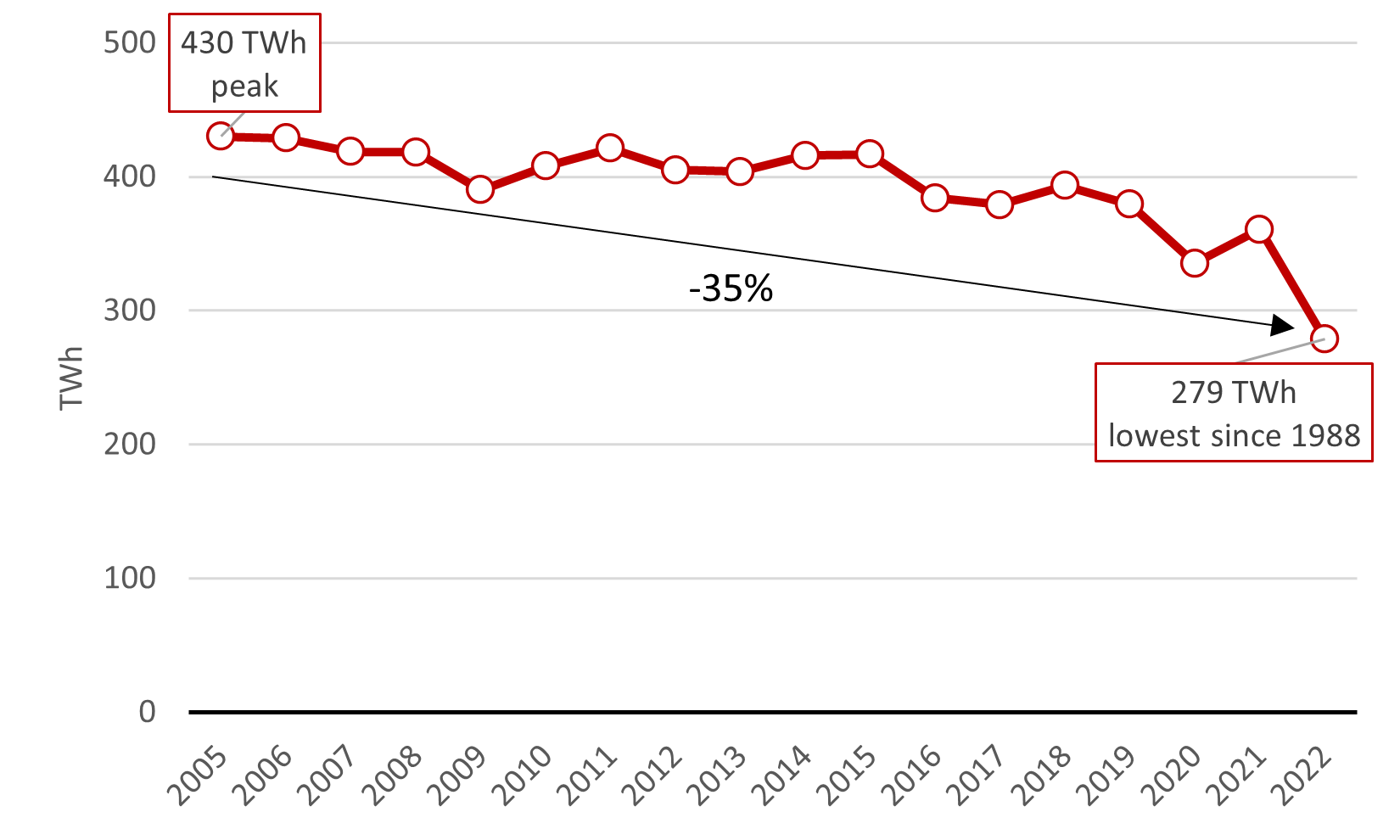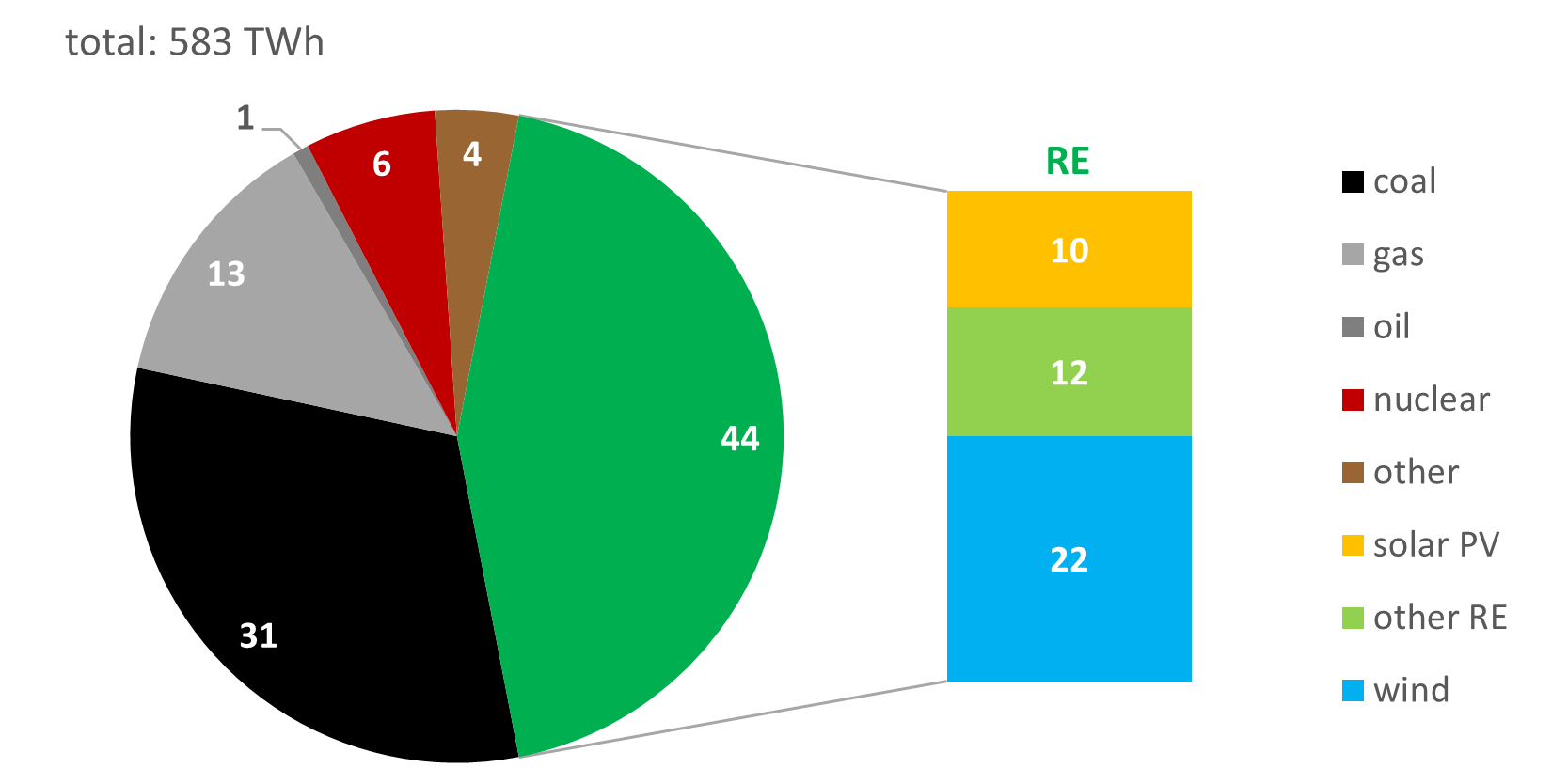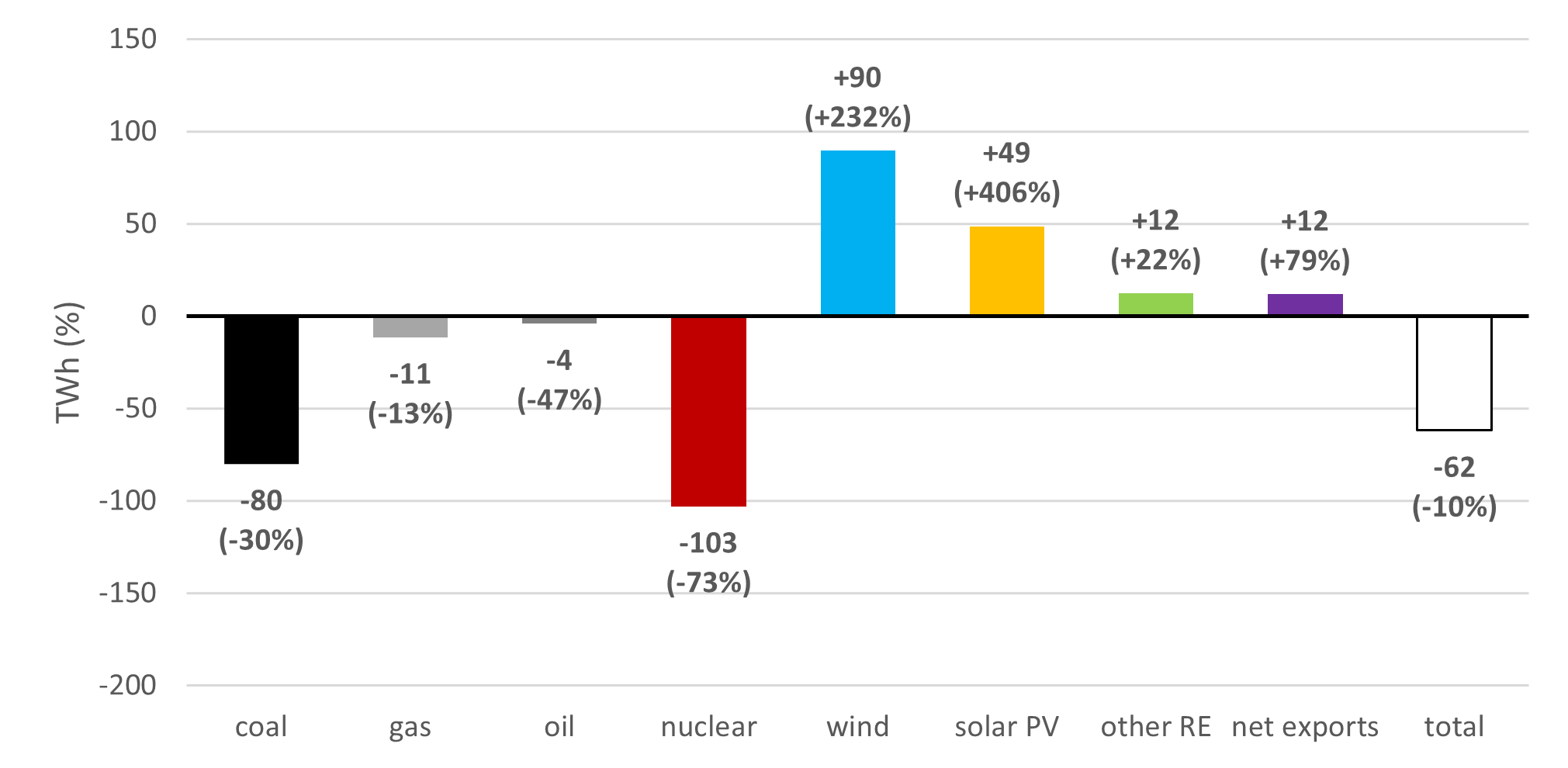The Japanese government’s active promotion of nuclear power is based on a questionable selection of information about nuclear power in Europe.1The information selected is all in favor of nuclear power and the resulting presentation necessarily biased. The Japanese public deserves a balanced presentation of nuclear power latest developments in Europe.
First, France’s top priority is to fix ongoing nuclear power issues affecting existing aging reactors as well as the country’s sole reactor under construction (Flamanville-3). Second, after a short 3.5-month delay, Germany will have succeeded in realizing its nuclear power phaseout on April 15, 2023. Third, the European Union Taxonomy includes nuclear power, but under strict conditions for radioactive waste disposal.
France’s Top Priority Is to Fix Ongoing Nuclear Power Issues
In 2022, with only 279 terawatt-hours (TWh) electricity generation from nuclear power in France was at its lowest level since 1988.2 Compared to the country’s historical nuclear power peak of 430 TWh in 2005, this is a 35% decrease (Chart 1).

More recently, the period between January 1 and March 26, 2023 (i.e., almost the entire first quarter of the year – latest data available at the time of writing) has been even worse for nuclear power than the same period in 2022: 81 TWh against 88 TWh, a drop of 8%. 3
These poor performances are mainly due to the combination of three factors negatively affecting existing French nuclear reactors. First, the “Grand Carénage”, a program focusing on safety upgrades and reactor lifetime extensions taking place from 2014 to 2025. This heavy program covers all the country’s 56 existing nuclear reactors (61.370 gigawatts (GW), the average age of the fleet is around 38 years) and temporarily limits their availability.4 Second, since 2020 the COVID-19 pandemic has derailed the maintenance of reactors which is usually tuned like clockwork. Third, from the end of 2021 discoveries of stress corrosion cracking in emergency cooling systems led to temporary reactor shutdowns for inspections and repairs.
Regarding lifetime extensions of nuclear reactors in France, they may be granted by the Autorité de Sûreté Nucléaire (i.e., the country’s nuclear safety authority) every 10 years after the start of a reactor. Outage periods are included in the lifespan of a reactor, which is a practice in line with the International Atomic Energy Agency’s longstanding position considering a mothballed reactor not being immune from the effects of ageing.5 In comparison, Japan’s new approach is to allow for lifetime extensions every 10 years 30 years after the start of a reactor, and to exclude outage periods from the lifespan of a reactor. This new approach is inappropriate in terms of safety.
Moreover, Flamanville-3 (1.630 GW), France’s sole nuclear reactor under construction – since December 2007, suffers endless delays (more than 11 years) and enormous cost overruns (over €11 billion). Into more details, Flamanville-3 was originally planned to start operation in June 2012 and cost €4.6 billion.6 In its latest update in December 2022, Électricité de France, the company leading this project, noted that the start of operation will not take place before the first quarter of 2024 and that the cost increased to €16.1 billion.7
As a result of these negative developments, France – for the first time since 1980 – became again a net importer of electricity in 2022: 17 TWh, or approximately 4% of the country’s electricity consumption.8 These net imports mostly came from Germany.
To revitalize nuclear power the French Parliament is currently discussing a law simplifying procedures to extend the lifetime of existing reactors and build new ones.9 For existing reactors, France pursues lifetime extensions of all reactors. The law being discussed simplifies the periodic review procedure for reactors approaching 40 years. For new reactors, France aims to build 6-14 large reactors and small modular reactors. The law being discussed exempts from construction permits new reactors to be built near existing reactors, saving time. These measures should be helpful. However, for France to meet its nuclear power objectives, strengthening its deficient supply chain and finding solutions to finance massive investments remain critical.
Since France promotes both nuclear power and renewable energy (RE) to reach carbon neutrality by 2050, it is also worth noting here that the French Parliament already adopted a new law to accelerate RE deployment in March 2023.10This law is based on four pillars: (1) identification of local acceleration zones for RE deployment, (2) simplification of environmental procedures to reduce the time of projects, (3) mobilization of land for RE (e.g., facilitation of solar panels installation on already artificialized land), and (4) implementation of a redistribution mechanism to better share RE benefits with local communities. These measures are heading in the right direction and their adoption was necessary for France to keep its RE 2050 targets credible – a challenge given France’s unimpressive RE track record: solar at least 100 GW (15.7 GW in 2022) and on- & off-shore wind both 40 GW (20.6 GW and 0.5 GW, respectively in 2022).11
Finally, it may be noted that before these laws were discussed (nuclear power) and adopted (RE), France had announced goals to reduce the share of nuclear power in its electricity generation mix to 50% by 2035 (63% in 2022) and increase that of RE to 40% by 2030 (25% in 2022).12 The goal for nuclear power is being abandoned. The goal for RE can only be reached if the new law delivers the required acceleration, which given its recent adoption is premature to evaluate.
After a Short Delay Germany Is about to Successfully Phase-Out Nuclear Power
The invasion of Ukraine by Russia raised energy supply concerns across Europe last year. In Germany, this led the government to slightly revise its nuclear power phaseout plan on November 11, 2022. Instead of closing the country’s last 3 nuclear reactors (4.055 GW): Emsland (1.335 GW), Isar-2 (1.410 GW), and Neckarwestheim-2 (1.310 GW), on December 31, 2022, as originally planned, it was decided to postpone these shutdowns to April 15, 2023.13 This is a short delay of 3.5 months.
In 2022, the share of nuclear power in Germany’s electricity generation mix was a small 6%. In comparison the share of RE was 44% – about 7 times bigger (Chart 2).

Source: AG Energiebilanzen, Stromerzeugung nach Energieträgern (Strommix) von 1990 bis 2022 (in TWh) Deutschland insgesamt (December 2022) [in German].
Furthermore, it is important to note that not only Germany will soon have succeeded in phasing out nuclear power, but it will have done so by also substantially reducing electricity generation from all fossil fuels, especially coal: -80 TWh, or -30% from 2010 to 2022. These progresses were primarily made possible thanks to significant expansions of wind (both on- & off-shore) and solar photovoltaic (PV) (Chart 3).
Chart 3: Germany Change in Power Supply 2022-2010

Source: AG Energiebilanzen, Stromerzeugung nach Energieträgern (Strommix) von 1990 bis 2022 (in TWh) Deutschland insgesamt (December 2022) [in German].
Finally, it is interesting to observe that between 2010 and 2022 Germany’s net exports of electricity increased. In 2022, Germany’s massive net electricity exports (27 TWh) were particularly valuable to France who faced a lack of domestic electricity because of the nuclear power issues described in the previous section. More specifically, last year, Germany exported 21 TWh to France while it only imported 5 TWh from France.14
Strict Conditions for Radioactive Waste Disposal in the European Union Taxonomy
On July 15, 2022, the Complementary Climate Delegated Act, including nuclear power in the list of economic activities covered by the European Union (EU) Taxonomy (i.e., a classification system for sustainable activities) has been published in the Official Journal of the EU. This Act applies since January 1, 2023.15
The inclusion of nuclear power in the EU Taxonomy has been fiercely debated and remains seen as controversial by some EU Member States. At the center of all attentions was the issue of radioactive waste disposal. A compromise was reached by agreeing that EU Member States pursuing nuclear power in the framework of the EU Taxonomy should have in place a detailed plan to have in operation a disposal facility for high-level radioactive waste by 2050.16
The Complementary Climate Delegated Act states that a deep geological disposal facility is the “state of the art solution” for high-level radioactive waste and spent nuclear fuel. Therefore, it should be the solution implemented. This is a significant difficulty because there is no such operational disposal facility anywhere in the world today.
Finland leads global efforts and schedules to start the final disposal of spent fuel in the deep geological disposal facility ONKALO in the mid-2020s.17 It is followed by France and Sweden which are making concrete progress towards the construction of their own deep geological disposal facilities at already selected locations. Other countries, including Japan and the United States, lag.
- 1Japan Ministry of Economy, Trade and Industry – Agency for Natural Resources and Energy, エネルギー危機の時代、原子力発電をどうする? – March 20, 2023 (accessed March 23, 2022) [in Japanese].
- 2Réseau de Transport d'Électricité, Bilan Électrique 2022: Production – Nucléaire (February 2023) [in French].
- 3Réseau de Transport d'Électricité, Download eCO2mix Indicators (accessed March 27, 2023).
- 4International Atomic Energy Agency, Power Reactor Information System – Country Statistics: France – updated March 26, 2023 (accessed March 27, 2023).
- 5International Atomic Energy Agency, Safety Aspects of Nuclear Power Plant Ageing (January 1990).
- 6Cour des Comptes, La Filière EPR (July 2020) [in French].
- 7Électricité de France, Update on the Flamanville EPR – December 16, 2022 (accessed March 23, 2023).
- 8Réseau de Transport d'Électricité, Bilan Électrique 2022: Échanges – Vue d’Ensemble (February 2023) [in French].
- 9Vie Publique, Projet de Loi Relatif à l’Accélération des Procédures Liées à la Construction de Nouvelles Installations Nucléaires à Proximité de Sites Nucléaires Existants et au Fonctionnement des Installations Existantes – March 21, 2023 (accessed March 27, 2023) [in French].
- 10Vie Publique, Loi du 10 Mars 2023 Relative à l'Accélération de la Production d'Énergies Renouvelables – March 13, 2023 (accessed March 27, 2023) [in French].
- 11Réseau de Transport d'Électricité, Bilan Électrique 2022: Production – Vue d’Ensemble (February 2023) [in French].
- 12Ibid.
- 13Germany Federal Office for the Safety of Nuclear Waste Management, The Nuclear Phase-Out in Germany – November 11, 2022 (accessed March 23, 2023).
- 14European Network of Transmission System Operators for Electricity, Transparency Platform: Scheduled Commercial Exchanges / France-Germany 2022 (accessed March 23, 2023).
- 15European Commission, EU taxonomy: Complementary Climate Delegated Act to accelerate decarbonization – updated July 11, 2022 (accessed March 23, 2023).
- 16Official Journal of the European Union, Commission Delegated Regulation (EU) 2022/1214 of March 9, 2022 – July 15, 2022 (accessed March 23, 2023).
- 17Posiva, Major Construction Work Progresses on Posiva’s ONKALO Worksite – December 5, 2022 (accessed March 23, 2023).






